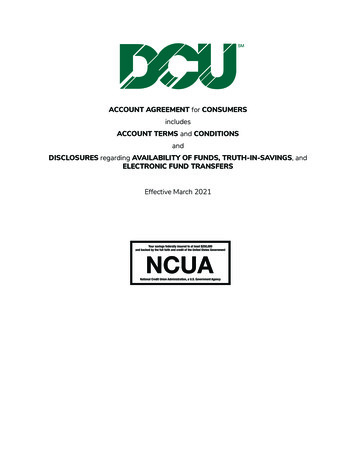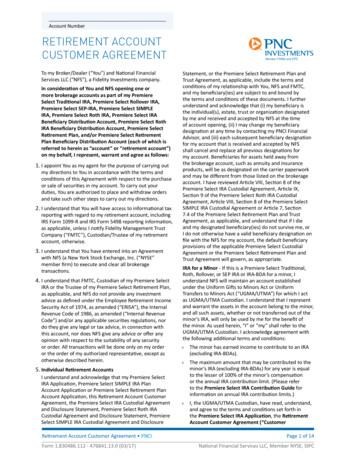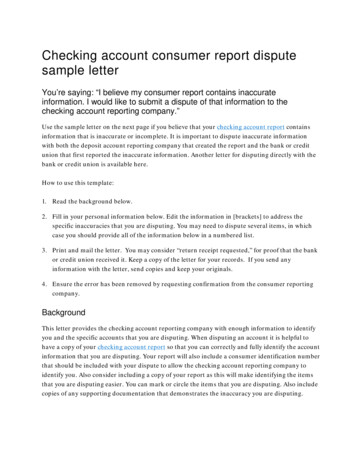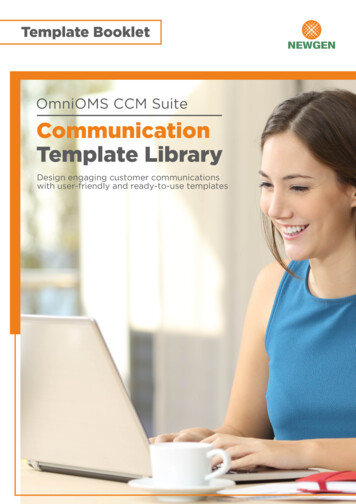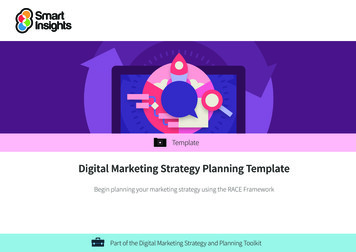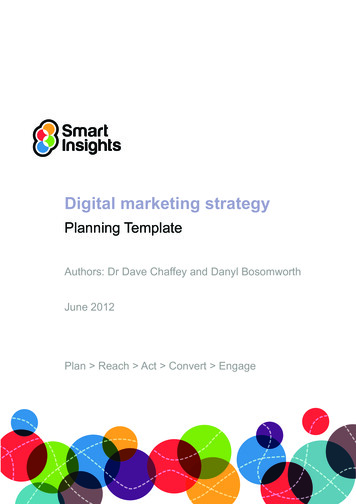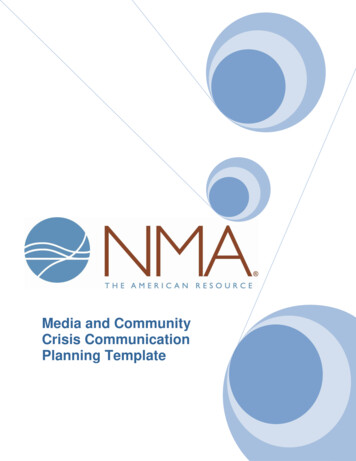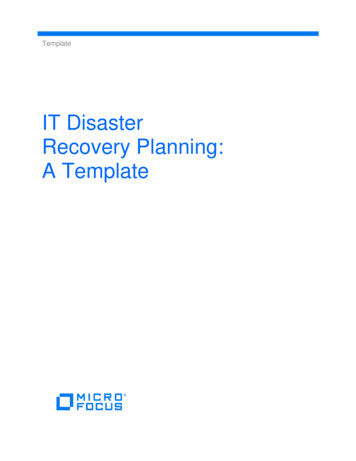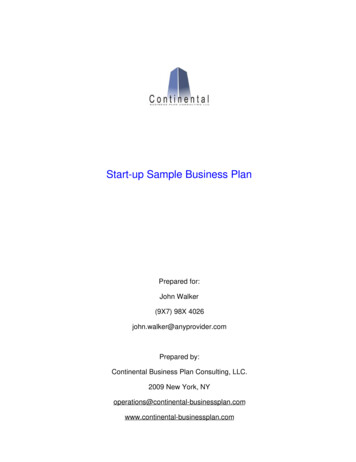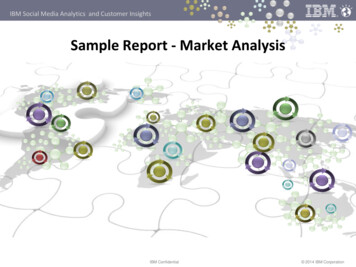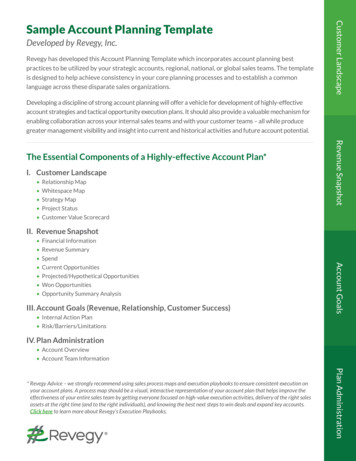
Transcription
Developed by Revegy, Inc.Revegy has developed this Account Planning Template which incorporates account planning bestpractices to be utilized by your strategic accounts, regional, national, or global sales teams. The templateis designed to help achieve consistency in your core planning processes and to establish a commonlanguage across these disparate sales organizations.Customer LandscapeSample Account Planning TemplateDeveloping a discipline of strong account planning will offer a vehicle for development of highly-effectiveaccount strategies and tactical opportunity execution plans. It should also provide a valuable mechanism forenabling collaboration across your internal sales teams and with your customer teams – all while producegreater management visibility and insight into current and historical activities and future account potential.I. Customer Landscape Relationship Map Whitespace Map Strategy Map Project StatusRevenue SnapshotThe Essential Components of a Highly-effective Account Plan* Customer Value ScorecardII. Revenue Snapshot Financial Information Revenue Summary Spend Projected/Hypothetical Opportunities Won Opportunities Opportunity Summary AnalysisIII. Account Goals (Revenue, Relationship, Customer Success)Account Goals Current Opportunities Internal Action Plan Risk/Barriers/LimitationsIV. Plan Administration Account Overview Account Team InformationPlan Administration* Revegy Advice – we strongly recommend using sales process maps and execution playbooks to ensure consistent execution onyour account plans. A process map should be a visual, interactive representation of your account plan that helps improve theeffectiveness of your entire sales team by getting everyone focused on high-value execution activities, delivery of the right salesassets at the right time (and to the right individuals), and knowing the best next steps to win deals and expand key accounts.Click here to learn more about Revegy’s Execution Playbooks.
Relationship MapThe Relationship Map is a visual representation of all the key stakeholders and influencers. The maprepresents friends, foes, and third-party influencers, which is critical to help your team identify risks andbuild quality close plans. You may also leverage social media and business content providers to researchindividuals, connections and determine the relationships you need to foster to be successful.Customer LandscapeI. Customer LandscapeBest practice stakeholder attributes when building a Relationship Map are: Role Influence PreferenceTo build a Relationship Map use your Revegy advanced mapping tool or the area below. Click here to see asample of the Revegy Relationship Map.Revenue Snapshot RelationshipAccount GoalsPlan Administration
Whitespace MapThe Whitespace Map allows you to visualize your current solution footprint, identify cross-sell and upsell opportunities, and see where your competition is entrenched.Best practice attributes when building a Whitespace Map are: Solutions Status- Our solution is currently in use- Competitor solution in use- No solution in useCustomer LandscapeI. Customer Landscape- N/A Competitor (if specified) Estimated value for potential future opportunitiesTo build a Whitespace Map use your Revegy advanced mapping tool or the area below. Click here to see asample of the Revegy White Space Map.Revenue Snapshot Estimated value for existing opportunitiesAccount GoalsPlan Administration
Strategy Alignment MapA Strategy Alignment Map is a visual representation that documents your customer’s key business goalsand initiatives, aligns these strategic initiatives with key stakeholders and aligns your capabilities accordingly.This valuable map is a key facilitator for collaborating with your customer and helps you and yourorganization gain greater credibility, value and further insight into the true business potential of an account.Customer LandscapeI. Customer LandscapeBest practice attributes when building a Strategy Alignment Map are: Type (goals, strategy, etc) Summary statement Strategy owner (should tie back to a person on the relationship map)To build a Strategy Alignment Map use your Revegy advanced mapping tool or the area below. Click here to seea sample of the Revegy Strategy Alignment Map.Revenue Snapshot Your solution that will assist the customer in achieving strategic goalsAccount GoalsPlan Administration
Project StatusA key component to the Customer Landscape is to document the Project Status of any relevantcustomer projects that could impact your overall Account Planning.The key information Revegy recommends you document and keep updated include the following:ProjectProject TypeOwnerCustomer LandscapeI. Customer LandscapeCommentsThe Customer Value Scorecard helps sales teams quickly visualize where to focus time and efforton building overall customer value.Revenue SnapshotCustomer Value ScorecardRelationshipWhat is the status of our relationship with the client?How high in the customer organization is our relationship?Perceived ValueDoes the customer see value in our products?Does the customer see value in our services?ContactHow often do we meet to review the customer’s strategic objectives?(Annually, Quarterly, Monthly, Never, Other)Account GoalsDoes the customer see value in our relationship?How often do customers contact you with requirements?(Annually, Quarterly, Monthly, Never, Other)SatisfactionCustomer's overall satisfaction with us?Customer's satisfaction with our products?Plan AdministrationCustomer's satisfaction with our services?
Financial InformationThe key Financial Information that should be collected to build an Account Plan includes:Revenue last fiscal yearRevenue this fiscal yearCustomer LandscapeII. Revenue SnapshotRevenue growth rateCommentsRevenue SnapshotNet Income last fiscal yearNet Income this fiscal yearNet Income growth rateCommentsRevenue SummaryThe key Revenue Information that should be collected to build an Account Plan includes:FY-2FY-1Current FYFY 1Trend ( /-)Account GoalsSolution (or Business Unit)Plan Administration
SpendThe key Spend Information that should be collected to build an Account Plan includes:AreaVendorAmountGrowth Rate Trend ( /-)NotesDocument opportunities you have won this year and the value of those opportunities.Opportunity NameTypeStageValueClose Date CompetitorCurrent OpportunitiesDocument the active deals/projects for this account that you expect to close this year, including theprojected revenue and close dates.Opportunity NameStageValueClose Date CompetitorPlan AdministrationTotalTypeAccount GoalsTotalRevenue SnapshotWon OpportunitiesCustomer LandscapeII. Revenue Snapshot
Potential/Hypothetical OpportunitiesUse information within this plan to determine where there may be additional revenue potentialwithin this account. If you have a revenue goal for this account you should make sure you have enoughrevenue identified to allow you to achieve your goal.Opportunity NameTypeCustomer Product/Initiative ServicePotentialValueEstimatedClose DateCustomer LandscapeII. Revenue SnapshotStatusOpportunity Summary AnalysisRevenue SnapshotTotalCreate a summary view of all the opportunities for this account and where you currently are withregard to achieving the revenue goal for this account.Revenue Goal for this AccountTotal Value of Current Opportunities (from the table above)Total Value of Potential Opportunities (from the table above)Total value of all opportunitiesGap between revenue goal and value of all opportunitiesAccount GoalsTotal Value of Won Opportunities (from the table above)% of GoalPlan Administration
Internal Account PlanDrawing from the landscape and opportunity analysis, document your goals and objectives for theaccount (short-term and long-term), the primary individual(s) responsible for driving the actionsand the date to execute on these goals.Goal/Objective/ActionPerson ResponsibleCustomer LandscapeIII. Account GoalsDate DueRevenue SnapshotA critical step in developing an effective plan will be to identify and document risks, barriers orlimitations you are facing in an account, your strategies to overcome these obstacles and the primaryowner of each.Risk/Barrier/LimitationHow to overcome?Account GoalsRisk/Barriers/LimitationsPerson ResponsiblePlan Administration
Account OverviewDocument and maintain the general information on the account. It is critical that this information is keptcurrent at all times.Account NameAccount OwnerCustomer LandscapeIV. Plan AdministrationPublic/PrivateAnnual RevenueCustomer Since (Year)Revenue SnapshotBuying/Licensing LocationsNumber of EmployeesFiscal Year EndCompany WebsiteAddressPhoneAccount Team InformationDocument the members of your account team and the primary role each individual is expected to play.NameTitleEmailPhoneRoleAccount GoalsPlan Administration
Sample Relationship MapCustomer LandscapeV. AppendixRevenue SnapshotSample Whitespace MapAccount GoalsPlan Administration
Sample Strategy Alignment MapCustomer LandscapeV. AppendixRevenue SnapshotAccount GoalsPlan Administration
Achieve Account Planning Excellence with RevegyContact us to schedule a demo of the Revegy sales planning and execution tools today.Call 404.998.5700 or visit www.revegy.com/contact-us.About RevegyRevegy’s technology makes sales planning and execution happen – providing process consistency and collaborationacross all facets of a sales organization. Using our visual tools sales teams gain efficiencies and sell more strategically.Revegy guides you through every step of the way from account strategy and planning to deal execution. It helps navigaterisks, gain competitive advantage and expand opportunities throughout the sales process so you can grow accountrevenue, win more deals and improve forecast accuracy. Revegy serves B2B sales organizations that have complex salescycles and our customers include leading organizations such as SAS, Oracle, JDA, Informatica. Ryder, Fiserv, First Data,McAfee, Allscripts, QAD, SAP, mongoDB, Redhat and GE. For more information visit www.revegy.com.Follow us on Twitter:Follow us on LinkedIn:Follow us on Google Plus:
I. Customer Landscape Relationship Map The Relationship Map is a visual representation of all the key stakeholders and influencers. The map represents friends, foes, and third-party influencer

